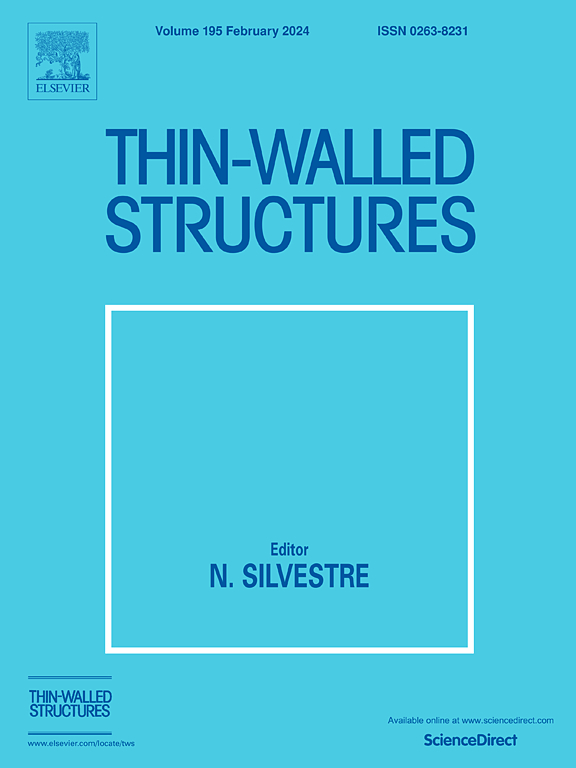具有优异强度、吸能和隔振性能的可调仿生晶格超材料
IF 6.6
1区 工程技术
Q1 ENGINEERING, CIVIL
引用次数: 0
摘要
在轻质点阵超材料的设计中,实现卓越的机械性能、可调性和卓越的隔振性能的无缝集成是一项重大进步。本文以山茱萸的形态结构和生物力学机制为灵感,提出了两种新型的晶格结构,它们具有高强度、高能量吸收、应力平台可调、变形模式可控和有效隔振等多种功能。结果表明,以山茱萸为灵感的矩形梁晶格(cdi - rb)具有令人印象深刻的抗压强度(高达56.14 MPa)和卓越的能量吸收(高达32.1 J/cm³),超过基准设计。两个晶格的可调性是通过几何参数调制和阶梯设计实现的,允许控制应力-应变响应中的应力平台的数量和高度。改进的圆筒形梁山茱萸晶格(cdi - ctb)具有稳定的应力响应,同时保持了高强度(高达76.55 MPa)和能量吸收能力(高达42.25 J/cm³),解决了原始cdi - rb晶格的不稳定性问题。此外,受山茱萸天然隔振机制的启发,将局部共振策略纳入晶格设计以增强隔振。一种设计在7.4-121.6 kHz频率范围内实现了多个不同的完整带隙,展示了有效的宽带隔振。所提出的晶格具有优异的机械性能,使其非常适合于隔振结构设计。本文章由计算机程序翻译,如有差异,请以英文原文为准。
Tunable bioinspired lattice metamaterials with excellent strength, energy absorption and vibration insulation
In the design of lightweight lattice metamaterials, achieving a seamless integration of exceptional mechanical properties, tunability, and superior vibration isolation performance represents a significant advancement. Here, we propose two novel lattice structures inspired by the morphological architecture and biomechanical mechanisms of Chinese dogwood (Cornus kousa), which demonstrate remarkable multifunctional performance, including high strength, high energy absorption, tunable stress plateaus, controllable deformation modes, and effective vibration isolation. The results demonstrate that the Chinese dogwood-inspired lattice with rectangular beams (CDiL-RB) achieves impressive compressive strength (up to 56.14 MPa) and exceptional energy absorption (up to 32.1 J/cm³), surpassing benchmark designs. The tunability of the two lattices is enabled by geometric parameter modulation and stair-stepping design, allowing control over the number and height of stress plateaus in their stress-strain response. The modified Chinese dogwood-inspired lattice with circular tubular beams (CDiL-CTB) exhibits stable stress responses while retaining high strength (up to 76.55 MPa) and energy absorption capacity (up to 42.25 J/cm³), addressing the instability observed in the original CDiL-RB lattice. Furthermore, inspired by the natural vibration-isolation mechanisms of Chinese dogwood, a local resonance strategy is incorporated into lattice designs to enhance vibration isolation. One design achieves multiple distinct complete bandgaps across the 7.4–121.6 kHz frequency range, demonstrating effective broadband vibration isolation. The proposed lattices exhibit exceptional mechanical properties, making them ideally suited for vibration isolation structural designs.
求助全文
通过发布文献求助,成功后即可免费获取论文全文。
去求助
来源期刊

Thin-Walled Structures
工程技术-工程:土木
CiteScore
9.60
自引率
20.30%
发文量
801
审稿时长
66 days
期刊介绍:
Thin-walled structures comprises an important and growing proportion of engineering construction with areas of application becoming increasingly diverse, ranging from aircraft, bridges, ships and oil rigs to storage vessels, industrial buildings and warehouses.
Many factors, including cost and weight economy, new materials and processes and the growth of powerful methods of analysis have contributed to this growth, and led to the need for a journal which concentrates specifically on structures in which problems arise due to the thinness of the walls. This field includes cold– formed sections, plate and shell structures, reinforced plastics structures and aluminium structures, and is of importance in many branches of engineering.
The primary criterion for consideration of papers in Thin–Walled Structures is that they must be concerned with thin–walled structures or the basic problems inherent in thin–walled structures. Provided this criterion is satisfied no restriction is placed on the type of construction, material or field of application. Papers on theory, experiment, design, etc., are published and it is expected that many papers will contain aspects of all three.
 求助内容:
求助内容: 应助结果提醒方式:
应助结果提醒方式:


